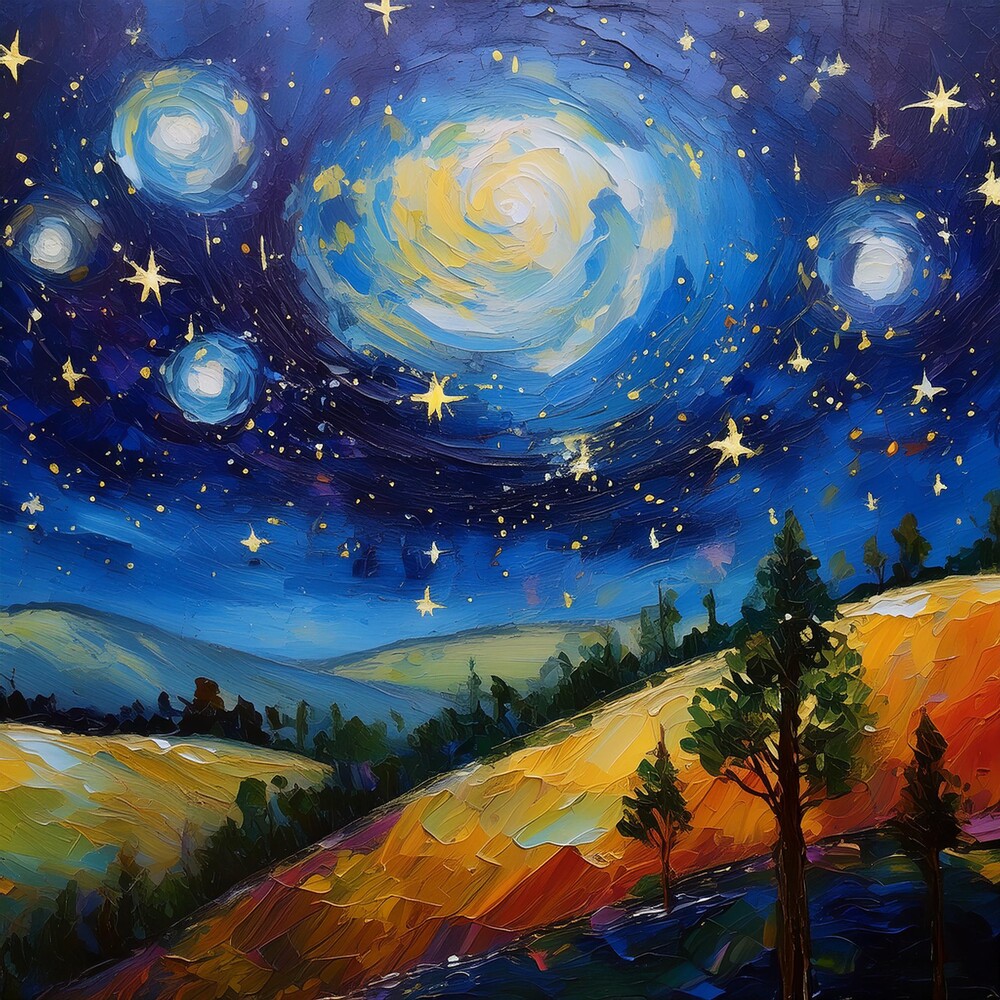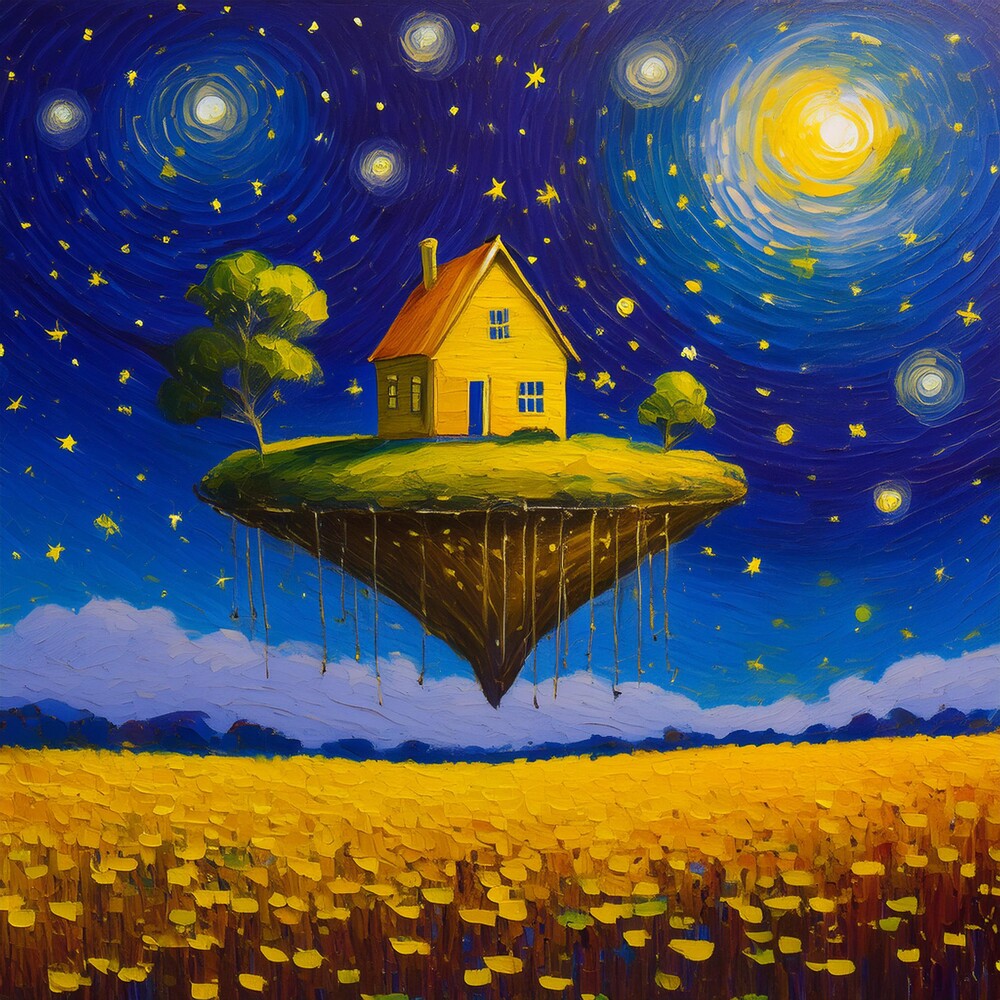Hues & Logic
Background
Nestled atop a square-shaped hill at the end of a winding road, there is a house full of stories, ideas, and inspiration. Its foundation is robust, its skeleton solid, and its insulation system resilient against the fiercest storms. At a distance, the vibrant spectrum of green, orange, violet, blue, red, and brown shingles adorning its exterior creates an artistic masterpiece. Each shingle, painted in a seemingly spontaneous manner, contributes to the kaleidoscopic charm of the house. Venture inside, and you'll discover a symphony of colors, with no two walls sharing the same hue, complemented by masterpieces like Salvador Dalí’s Meditative Rose and Claude Monet’s Impression, Sunrise and bookshelves full of the works of Plato, Immanuel Kant, and Albert Camus.
This is the abode crafted by Hues and Logic, where walls reverberate with tales waiting to be heard. In her studio, Hues, surrounded by an array of paintings, captures the elusive color of a rose's scent. In the countryside, amidst wildflowers, she seeks words to describe the subtle hum of intertwining blades of grass. In a crowded room, her eyes fixate on the spaces between people, finding meaning in absence. Yet, even in a crowd, she remains alone, encased in the walls of her creativity.

One morning, a desire to meet someone with a profound understanding of the significance of absence gripped Hues. She embarked on a journey eastward, leaving footprints on the dirt path meandering up a square-shaped hill.
Before living in the house, Logic lived everywhere. He was a nomad who traversed cities and towns, sought patterns in people, places, and the celestial heavens. Armed with the ability to discern truth from falsehood and a desire to unveil the order in the seemingly chaotic world, Logic chased a theorem to explain it all. His abilities lie in calculating if a statement is true or false, inferring the validity of any system using strict principles, and making reasonable conclusions based on any given information. He wants to know how, with his ordered thoughts, he would be able to distinguish good reasoning from bad reasoning, and in doing so, find meaning in a meaningless world.

On a clear morning, Logic began his day by tracing the trail of helter-skelter footprints that tip-toed their way to the top of a square-shaped hill. He observed the inconsistency in their weight distribution, almost as if their owner was dancing her way up the trail. He began placing his large, sturdy boots in the tiny footprints before him, intent on understanding why two footprints were so close together they almost touched, and another two so wide apart, almost as if their owner were doing the splits as they walked. He knew that when he met this person, it would all make sense.
When Logic first met Hues, she was standing at the jutting edge of the hill, peering up into the horizon, squinting her eyes in taut concentration.
“What are you looking for?” He asked simply, tonelessly, by way of introduction.
Hues whirled around in a circle, surprised by the intrusion. “If you must know, I’m looking for someone,” she answered brightly.
“If you’re looking for someone, why are you looking up, not down? The town center is just below us, and I’m certain you’ll be able to spot whoever it is you’re looking for from this distance,” Logic offered practically.
“What if the person I’m looking for is invisible? After all, aren’t the greatest accomplishments of this world intangible?” Hues responded, tentatively smiling.
“Indeed, yet what is intangible? After all, if we can attach a thought to something and rationalize it, doesn’t it take a tangible form, at least in our minds?
Hues paused, considering. “But how can we trace our thoughts, the singularity of a lost idea?”
“No ideas are lost. We write them down.”
With that, Hues and Logic began to converse.

As the days turned into nights, their words began to take physical form. While Hues and Logic discussed the epistemological origins of colors, the duality of good and evil, and the gray spaces between immorality and morality, they began building a house with their words.
Weeks passed, and a cement foundation appeared in the dirt beside them. As Logic spoke, a complete rough framing emerged, transforming in minutes into a complete skeleton. The floors, walls, and roof grew steady and strong. An insulation system systematically strengthened its interior. When Hues responded to Logic, shades of bright colors flickered over the house’s shingles, walls, and details. Tones of greens and blues, violets and oranges, browns, reds, and even grays breathed inspiration into the wooden house. And with their color, the walls came to life.
This collaborative effort yields a house that harmonizes objectivity and subjectivity, creativity and rationality. It stands as a testament to the power of collaboration, a structure that captivates with its organization and astounds with its vibrant colors. This is the house that Hues and Logic built together, where the writing on the walls echoes with a unique resonance, inviting careful contemplation.
What is Hues & Logic?
Essay writing serves as a unique intellectual activity that seamlessly bridges the realms of the arts and sciences, creating a harmonious intersection of creativity and logical reasoning. Here, Hues & Logic each represents arts and sciences, respectively.
In the arts, essays become a canvas for expression, allowing individuals to convey thoughts, emotions, and perspectives with eloquence and depth. Language becomes a tool for artistic craftsmanship: we can evoke powerful emotions through carefully chosen words and rhetorical devices. Moreover, the artistry of essay writing lies in the ability to craft a compelling narrative, weaving together ideas to create a coherent and engaging tapestry of thought.
On the other hand, essay writing is inherently rooted in scientific principles, requiring a structured and analytical approach to presenting information and formulating arguments. It demands meticulous research, critical thinking, and evidence-based reasoning. The scientific aspect of essay writing involves constructing logical arguments, supporting claims with empirical evidence, and adhering to established academic conventions. Essays in the sciences serve as a medium for knowledge dissemination, allowing individuals to communicate complex ideas and discoveries to a broader audience.
In essence, the intellectual activity of essay writing brings together the imaginative flair of the arts (or Hues) with the rigor of the sciences (or Logic), fostering a holistic and integrative approach to intellectual exploration.
How does Hues & Logic work?
Let us find the right color and idea for you!
At J&B, we recognize the paramount importance of optimizing learning and outcome potentials for our clients. To achieve this, we have developed a robust methodology that seamlessly integrates cutting-edge educational theories with practical implementation strategies. The first phase of our approach involves a comprehensive needs assessment, where we collaborate closely with clients to identify their unique goals, challenges, and learning objectives. This initial step sets the foundation for a tailored learning experience that aligns with the specific needs and aspirations of our clients.
Let us help you meet your needs and wants in essay writing!
Following the needs assessment, for the second phase of our approach, we employ a dynamic blend of traditional and innovative teaching methods, ensuring a diverse and engaging learning environment. Our methodology emphasizes experiential learning, fostering hands-on experiences that actively involve participants in the learning process. This approach not only enhances knowledge retention but also promotes a deeper understanding of the subject matter.
Let us help you get results and ensure learning outcomes!
The final phase of our methodology revolves around continuous assessment and feedback mechanisms. We understand that learning is an iterative process, and regular evaluations allow us to gauge the effectiveness of our strategies and make necessary adjustments. Through ongoing feedback loops, we ensure that clients receive personalized attention, addressing any emerging challenges and refining the learning experience as needed. By prioritizing collaboration and adaptability, our methodology guarantees that clients not only maximize their learning potential but also achieve tangible outcomes that align with their learning objectives.
